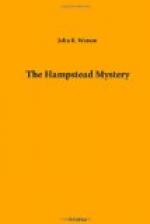“I haven’t seen the body yet,” said Rolfe. “I’d like to look at it. Where is it?”
“I had it removed downstairs. You will find it in a big room on the left as you go down the hall. By the by, there is another matter, Rolfe. This glove was found in the room. It may be a clue, but it is more likely that it is one of Sir Horace’s gloves and that he lost the other one on his way up from Scotland. It’s a left-hand glove—men always lose the right-hand glove because they take it off so often. I’ve compared it with other gloves in Sir Horace’s wardrobe, and I find it is the same size and much the same quality. But find out from Sir Horace’s hosier if he sold it. Here’s the address of the hosiers,—Bruden and Marshall, in the Strand.”
Rolfe went slowly downstairs into the room in which the corpse lay, and closed the door behind him. It was a very large room, overlooking the garden on the right side of the house. Somebody had lowered the Venetian blinds as a conventional intimation to the outside world that the house was one of mourning, and the room was almost dark. For nearly a minute Rolfe stood in silence, his hand resting on the knob of the door he had closed behind him. Gradually the outline of the room and the objects within it began to reveal themselves in shadowy shape as his eyes became accustomed to the dim light. He had a growing impression of a big lofty room, with heavy furniture, and a huddled up figure lying on a couch at the end furthest from the window and deepest in shadow.
He stepped across to the window and gently raised one of the blinds. The light of an August sun penetrated through the screen of trees in front of the house and revealed the interior of the room more clearly. Rolfe was amazed at its size. From the window to the couch at the other end of the room, where the body lay, was nearly thirty feet. Glancing down the apartment, he noticed that it was really two rooms, divided in the middle by folding doors. These doors folded neatly into a slightly protruding ridge or arch almost opposite the door by which he had entered, and were screened from observation by heavy damask curtains, which drooped over the archway slightly into the room.
Evidently the deceased judge had been in the habit of using the divided rooms as a single apartment, for the heavier furniture in both halves of it was of the same pattern. The chairs and tables were of heavy, ponderous, mid-Victorian make, and they were matched by a number of old-fashioned mahogany sideboards and presses, arranged methodically at regular intervals on both sides of the room. Rolfe, as his eye took in these articles, wondered why Sir Horace Fewbanks had bought so many. One sideboard, a vast piece of furniture fully eight feet long, had a whisky decanter and siphon of soda water on it, as though Sir Horace had served himself with refreshments on his return to the house. The tops of the other sideboards were bare, and the presses, use in such a room Rolfe was at a loss to conjecture, were locked up. The antique sombre uniformity of the furniture as a whole was broken at odd intervals by several articles of bizarre modernity, including a few daring French prints, which struck an odd note of incongruity in such a room.




